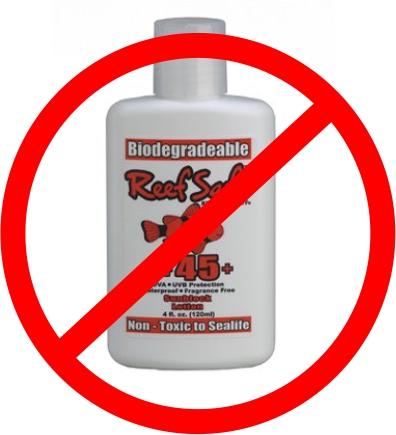
Continued from Home Page
...A few "Do's and Don'ts" - continued from page one.
.......coral structures or spiny
urchins, damaging them and possibly
getting a nasty scrape or urchin spines
imbedded in your skin. Coral structures
take years to grow, and many have sharp
edges or stinging polyps that can be
troublesome if you get a scrape.
In addition, most rock surfaces are not
free of living organisms. Algae,
barnacles, snails, bryozoans, and
other small animals live on the
surfaces.
Researchers are finding
some compounds in many sunscreens can
harm the coral on our reefs. Chemicals
in sunscreen can awaken coral viruses.
The coral then becomes sick and expel
their life-giving algae. Without these
algae, the coral “bleaches” (turns
white), and often dies.
And MOST sun blocks (86%) AREN'T SAFE for HUMANS either.
Use chemically free (coral safe) sun blocks.
Do not under-estimate the intense rays of our sub-tropical sun. Always use sun block. If you are going to be in the water, use a reef safe sun block. "Reef Safe" (the term, not a brand name) means that there are no chemicals in the lotion that can possibly inhibit the coral polyp's own defense against the sun's ultraviolet rays. Researchers are finding that while protecting humans, some compounds in many sunscreens can harm the coral on our reefs. Researchers testing the effects of sunscreen on corals explain that chemicals in sunscreen can awaken coral viruses. The coral then becomes sick and expel their life-giving algae. Without these algae, the coral “bleaches” (turns white), and often dies.
Always apply your sun screen at least 20 minutes before going in the water so your skin has time to absorb it rather than just getting washed off in the water.
THE BEST PROTECTION for you and the coral reefs is to cover up. If you are planning to spend many hours in the water, an SPF 50 long sleeved shirt and pants is the way to go. Having that layer of protection against the sun means you only have to use sun block on your face, hands and ankles. It also provides a layer of protection against any possible contact with small stinging jellyfishes and hydroids. (You'll find you won't get chilled as fast either.)

Any sunblock that has oxybenzone, butylparaben, octinoxate or 4 mathylbenzlidone camphor ARE NOT REEF SAFE. In fact the REEF SAFE brand of sunscreen contains the #1 harmful ingredient oxybenzone in it.
Informative Articles:
The impacts of sunscreens on our coral reefs
Comprehensive info from Badger Balm
Best Snorkeling Sunscreen Test Results
Brand Choices
- Coral Safe Brand / Biodegradable SPF 30
- Rubber Ducky All Natural SPF 30
- Raw Elements USA Eco Formula SPF 30
- Badger Sunscreen Cream, Unscented, SPF 30
- Badger Broad Spectrum Sport Facestick, SPF 35
- ECO logical All Natural Sunscreen, SPF 30+
- Elemental Herbs Sport Sunscreen, SPF 30+
- Green Screen D Organic Sunscreen, Original, SPF 35
- BurnOut Ocean Tested Physical Sunscreen, SPF 30
- DeVita Professional Skin Care - Ultra Solar 50
- All Terrain KidSport SPF30*
-
Keys Solar Rx Broad Spectrum SPF 30
* This option received a score of “3” but was the best option if you want a spray sunscreen
Use of fins.
As mention in the "Beginner Tips" article, when out snorkeling in our shallow, calm bays, the use of scuba diving fins is unnecessary. Wear short swim training fins or "Zip" fins. They are easier on the ankles, minimize the chance of coral damage AND you can walk in them!
Use the ID Gallery to become familiar with those species that could be a hazard.
Be an Observer
The wildlife you will be observing is going about the business of surviving. They may be hunting for food, looking for a mate, guarding young or defending their territory. Many fish and other creatures are in their rest cycle during the day under rock overhangs. Disturbing them during this time puts undo stress on their already stressful lives. Do not remove marine animals from the water (like hermit crabs, starfish and cucumbers-etc.) They live in the water and they BREATH underwater. Removing them means they will start suffocating.(Not a pleasant experience). Do not remove conch shells. Nine times out of ten there is a hermit crab (small hermits will occupy large shells) living inside. You will NOT see them. They will only crawl out of the shell when they are dying on your dashboard or in your pocket. So observe marine life in its natural state performing natural behavior. It is far more interesting and respectful than getting a souvenir or trying to get them to behave in an un-natural way. Many fish and other creatures are wary or shy and will swim away or duck for cover. If you are patient and remain still still for a time or move very slowly, many times, you will get another closer view. Remember, many species use camouflage for protection and it is only by slow careful observance that you will spot things otherwise overlooked. Use the Identification Gallery to familiarize yourself with hundreds of interesting creatures you may otherwise miss.
Never take glass to the beach.
This should be a simple matter of common sense, but needs to be said none the less.
Report LIONFISH sightings.
The Indo-Pacific Lionfish is an extremely aggressive invasive species that has devastated other Atlantic/Caribbean locations. It has now invaded the Virgin Islands. Efforts are underway to try to control its populations. They are also extremely VENEMOUS.